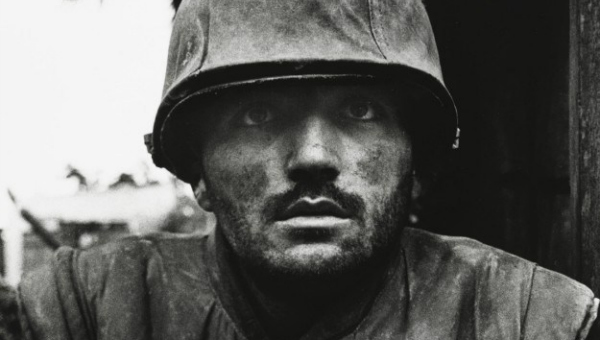McCULLIN is a documentary depicting the career of internationally celebrated photojournalist, Donald McCullin. Director/producers David and Jacqui Morris present a fascinating portrait of McCullin’s lifework by combining archival footage with exclusive interviews. Seldom do the filmmakers need to accentuate the emotion captured in McCullin’s photographs, to do so would be to do them a disservice and stifle their depiction of the truth. The directors’ tactful approach to their medium allows McCullin to use his own compelling, yet modest allure to describe his experiences and dilemmas while photographing some of the worst human atrocities post World War II.
The mechanical nature of photography enables its codec to present undeniable evidence of an event’s actuality. This means that in its purest form a photograph is not a personal artistic expression; it is an instance in time captured by an unsympathetic machine. A great painting, such as Guernica, can facilitate a deep expression and philosophical understanding of the effects of war, whereas a photograph is a literal and accurate record of a moment as it happens. Despite media studies revealing the illusionistic nature of the medium, photography still promises the best method for the documentation of humanity’s legacy without censorship from ideological prejudices and biases.
“McCullin’s ability to capture rare instances of intense emotion from his subjects echoes an intimacy more commonly attributed to Renaissance portraits”
The power in Don McCullin’s photography comes from his ability to see works of art in the reality of the events he is reporting. Although refuting suggestions that he is an artist, McCullin highlights that some of his work’s unabashed depiction of mutilated human bodies is somewhat reminiscent of Goya’s paintings. Indeed, McCullin’s ability to capture rare instances of intense emotion from his subjects echoes an intimacy more commonly attributed to Renaissance portraits. His authority comes from an ability to capture a single frame of reality in a war zone that resonates his experience of the horror that possesses these places.
Framing these instances within a film could have been problematic as they are delicate references to moments so often misrepresented by mainstream media that it is difficult to trust even the most principal of sources. If the frame should warp the subject in any way the message could become misconstrued or sensationalised, and presenting an honest account of the subject is the highest of McCullin’s priorities. Thankfully, the source material is treated with the utmost respect, and there is a refreshingly calm and sincere thread of integrity running throughout McCULLIN. The film documents McCullin’s legacy without straying from the maxim that his life is his own story to tell, warts and all. Just as his photographs have recorded pain so that others disjointed from it can understand it, this film has documented those aspects of photojournalism and his career that McCullin regards most pertinent to history.
It is an absolute pleasure to hear such unobtrusive descriptions of the events that McCullin immortalised with his camera, and those so terrible that he could not bear to photograph them. The incredible archival footage and a subtle score help to direct the viewer’s attention as McCullin’s account entertains, informs and appalls in equal measure. These are stories of high adventure, but devoid of fantasy, as they have been told through an unfeeling mechanical memory machine. The cushioning sensationalism of mainstream journalistic reporting on humanitarian disaster is removed and replaced with the cold metal of McCullin’s camera-body. In McCULLIN, his narrative is a natural extension of his photography. He reports the adventure that he has endured in order to reveal to us the evidence of extreme suffering in the world.



One thought on “McCullin”
Comments are closed.